ไข่ฟาแบร์เช
ไข่ฟาแบร์เช[1] (รัสเซีย: яйца Фаберже; อังกฤษ: Fabergé egg) คือหนึ่งในงานตกแต่งอัญมณีรูปไข่ที่สร้างโดยห้องงานอัญมณีฟาแบร์เช (House of Fabergé) ระหว่างปี ค.ศ. 1885 จนถึงปี ค.ศ. 1917 งานส่วนใหญ่เป็นงานชิ้นเล็กที่เหมาะกับการให้เป็นของขวัญสำหรับเทศกาลอีสเตอร์

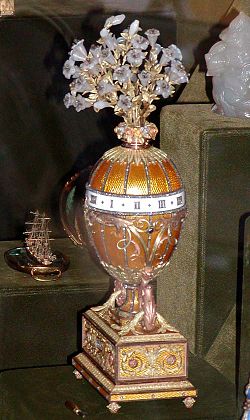
แต่ไข่ฟาแบร์เชที่มีชื่อเสียงที่สุดที่สร้างโดยห้องงานอัญมณีเป็นงานชิ้นใหญ่ที่สร้างให้แก่ซาร์อเล็กซานเดอร์ที่ 3 และ ซาร์นิโคลัสที่ 2 แห่งรัสเซีย ที่มีด้วยกันทั้งหมด 50 ชิ้น และ 43 ชิ้นได้ค้นพบแล้ว[2] อีกสองชิ้นสร้างแล้วเสร็จ 1 ใบ อีกใบยังไม่เสร็จ ได้แก่ กลุ่มดาวสีน้ำเงินแห่งซาเรวิช และ คาเรเลียนเบิร์ช สำหรับปี ค.ศ. 1917
ไข่ใบใหญ่เจ็ดใบสร้างให้แก่นักอุตสาหกรรมอเล็กซานเดอร์ เคลช์แห่งมอสโก[3]
ไข่ทำจากโลหะมีค่าหรือหินแข็งตกแต่งด้วยอัญมณีและการลงยา คำว่า “ไข่ฟาแบร์เช” มีความหมายเดียวกับความหรูหรา และถือกันว่าเป็นงานอัญมณีชั้นหนึ่ง “ไข่ฟาแบร์เช” ของราชวงศ์รัสเซียถือว่าเป็นกลุ่มงานศิลปะชิ้นเอก (objets d'art) ที่ได้รับการจ้างชิ้นสุดท้าย
ประวัติ
การสร้าง “ไข่ฟาแบร์เช” เริ่มขึ้นเมื่อซาร์อเล็กซานเดอร์ที่ 3 มีพระราชประสงค์ที่มอบไข่อีสเตอร์ให้แก่จักรพรรดินีมาเรีย เฟโดโรฟนา (Empress Maria Fedorovna) ในปี ค.ศ. 1885 เพื่ออาจจะในพระราชวโรกาสฉลองครอบรอบ 20 ปีของการเสกสมรสระหว่างทั้งสองพระองค์ เชื่อกันว่าซาร์อเล็กซานเดอร์ทรงได้ความคิดมาจากไข่ที่เป็นของเจ้าหญิงวิลเฮลมีน มารี แห่งเดนมาร์กผู้เป็นพระปิตุจฉาของพระจักรพรรดินี ที่เป็นวัตถุที่ต้องพระทัยจักรพรรดินีมาเรียมาตั้งแต่ยังทรงพระเยาว์
ไข่ใบแรกที่สร้างที่เรียกกันว่า “ไข่ไก่” ทำด้วยทอง โดยมีเปลือกเป็นทองคำเคลือบเอนนาเมลขาวใสที่เปิดขึ้นมาเป็นสิ่งที่ทำให้ประหลาดใจสิ่งแรกที่เป็นไข่แดงทองคำสีเหลืองนวล ที่เปิดออกมาเป็นไก่ทองคำระบายหลากสี ที่เปิดได้ ภายในเป็นมงกุฎจักรพรรดิเพชรขนาดเล็กที่ภายในบรรจุจี้ทับทิม แต่เป็นที่น่าเสียดายที่สองอย่างหลังนี้สูญหายไป[4]
จักรพรรดินีมาเรียทรงพอพระทัยกับของขวัญเป็นอันมาก จนพระราชสวามีต้องมีพระบรมราชโองการแต่งตั้งให้ฟาแบร์เชเป็น ‘ช่างทองผู้ได้รับการแต่งตั้งเป็นพิเศษแห่งจักรวรรดิ’ ปีต่อมาพระองค์ก็ทรงจ้างให้ฟาแบร์เชสร้างไข่ให้อีกใบหนึ่ง แต่หลังจากนั้น ปีเตอร์ คาร์ล ฟาแบร์เชผู้เป็นเจ้าของกิจการก็ได้รับอภิสิทธิ์ในการไข่อีสเตอร์สำหรับพระจักรพรรดิต่อมา การออกแบบก็เพิ่มความซับซ้อนขึ้นทุกปี ตามธรรมเนียมของตระกูลฟาแบร์เช แม้แต่พระเจ้าซาร์ก็ไม่ทราบว่าไข่จะออกมาในรูปใด ข้อแม้อย่างเดียวของการสร้างงานคือต้องประกอบด้วยสิ่งที่สร้างความประหลาดใจแก่ผู้ดู หลังจากการเสด็จสวรรคตของซาร์อเล็กซานเดอร์ที่ 3 ในปี ค.ศ. 1894 แล้ว ซาร์นิโคลัสที่ 2 พระราชโอรสก็ทรงมอบไข่ให้แก่ทั้งพระอัครมเหสีและพระราชชนนี
ในช่วงนี้ก็มิได้มีการสร้างไข่อยู่สองปี ในปี ค.ศ. 1904 และในปี ค.ศ. 1905 เพราะสงครามรัสเซีย-ญี่ปุ่น เมื่อแบบได้รับการอนุมัติจากฟาแบร์เชแล้ว ทีมช่างก็จะเริ่มทำงานประกอบไข่ขึ้น
ไข่อีสเตอร์สำหรับพระจักรพรรดิสร้างชื่อเสียงเป็นที่เลื่องลือให้แก่ฟาแบร์เช ผู้รับงานสร้างไข่ให้แก่ลูกค้าส่วนตัวที่เลือกสรรบ้างไม่กี่คน ที่รวมทั้งดัชเชสแห่งมาร์ลบะระห์, ตระกูลโนเบล, ตระกูลรอธไชลด์ และตระกูลยูซูพอฟ
รายชื่อไข่อีสเตอร์สำหรับพระจักรพรรดิ
| ปีที่สร้าง | ชื่อ | ภาพ | รายละเอียด | เจ้าของปัจจุบัน |
|---|---|---|---|---|
| 1885 | ไข่ไก่ |  | Also known as the Jeweled Hen Egg, it was the first in a series of 54 jeweled eggs made for the Russian Imperial family under Peter Carl Fabergé's supervision. It was delivered to Tsar Alexander III in 1885. The tsarina and the tsar enjoyed the egg so much that Alexander III ordered a new egg from Fabergé for his wife every Easter thereafter. | Viktor Vekselberg |
| 1886 | Hen with Sapphire Pendant |  | Also known as the Egg with Hen in Basket, it was made in 1886 for Alexander III, who presented it to his wife, the Empress Maria Feodorovna. | สูญหาย |
| 1887 | Third Imperial Egg | 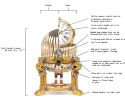 | A jewelled and ridged yellow gold Egg stands on its original tripod pedestal, which has chased lion paw feet and is encircled by coloured gold garlands suspended from cabochon blue sapphires topped with rose diamond set bows. In 2014 purchased by London-based jeweler Wartski on behalf of an unidentified private collector.[5] | Private Collection |
| 1888 | Cherub with Chariot | 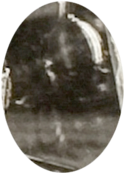 | Also known as the Angel with Egg in Chariot, crafted and delivered in 1888 to Alexander III. This is one of the lost Imperial eggs, so few details are known about it. | สูญหาย |
| 1889 | Nécessaire | 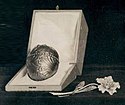 | Crafted and delivered to Alexander III, who presented it to his wife, Maria Feodorovna, on Easter 1889. | สูญหาย |
| 1890 | Danish Palaces |  | Crafted and delivered to Alexander III, who presented it to his wife, Maria Feodorovna, on Easter 1890. | Matilda Geddings Gray Foundation and housed in the Metropolitan Museum of Art in New York City, New York. |
| 1891 | Memory of Azov | 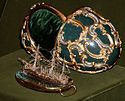 | Kremlin Armoury, Moscow, Russia | |
| 1892 | Diamond Trellis | 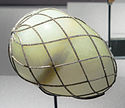 | Private Collection | |
| 1893 | Caucasus | 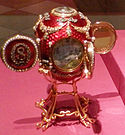 | Matilda Geddings Gray Foundation. Displayed in the Metropolitan Museum of Art in New York City, New York. | |
| 1894 | Renaissance |   | Viktor Vekselberg | |
| 1895 | Rosebud |  | Viktor Vekselberg | |
| 1895 | นาฬิกาสีฟ้า | 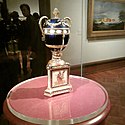 | Before March 2014 mistaken for the third imperial egg | Albert II of Monaco collection, Monte-Carlo, Monaco |
| 1896 | Rock Crystal | 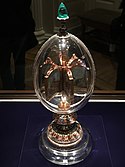 | Also known as Revolving Miniatures Egg | Virginia Museum of Fine Arts |
| 1896 | Twelve Monograms | 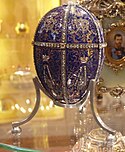 | Previously identified as the Twelve Monograms egg of 1895.[6] Surprise is missing. | พิพิธภัณฑ์ Hillwood, Washington, D.C., USA |
| 1897 | Imperial Coronation Egg | 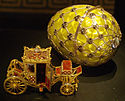 | Viktor Vekselberg | |
| 1897 | Mauve |  | สูญหาย Viktor Vekselberg | |
| 1898 | Lilies-of-the-Valley | 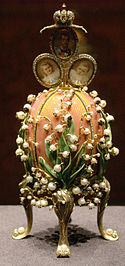 | Made under the supervision of the Russian jeweler Peter Carl Fabergé in 1898 by Fabergé ateliers. The supervising goldsmith was Michael Perchin. The egg is one of two in Art Nouveau style. It was presented on April 5 to Tsar Nicholas II, and was used as a gift to the tsaritsa, Empress Alexandra Fyodorovna. | Viktor Vekselberg |
| 1898 | Pelican | Virginia Museum of Fine Arts, Richmond, Virginia, USA | ||
| 1899 | Bouquet of Lilies Clock | 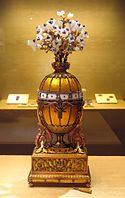 | Kremlin Armoury, Moscow, Russia | |
| 1899 | Pansy | 125px | Private Collection | |
| 1900 | Trans-Siberian Railway | 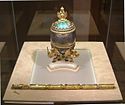 | Kremlin Armoury, Moscow, Russia | |
| 1900 | Cockerel | 125px | Viktor Vekselberg | |
| 1901 | ตะกร้าดอกไม้ | 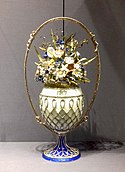 | Elizabeth II The Royal Collection, London, United Kingdom | |
| 1901 | Gatchina Palace | 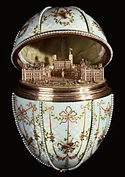 | Walters Art Museum, Baltimore, Maryland, USA | |
| 1902 | Clover Leaf | 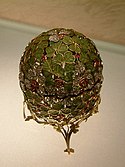 | Kremlin Armoury, Moscow, Russia | |
| 1902 | Empire Nephrite | 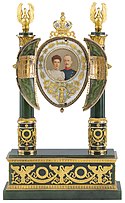 | Private Collection, USA | |
| 1903 | Peter the Great | 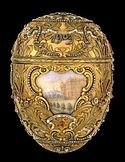 | Virginia Museum of Fine Arts, Richmond, Virginia, USA | |
| 1903 | Royal Danish | 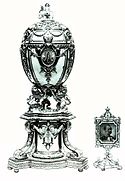 | สูญหาย | |
| 1904 | No eggs made | |||
| 1905 | No eggs made | |||
| 1906 | Moscow Kremlin | 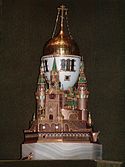 | Kremlin Armoury, Moscow, Russia | |
| 1906 | หงส์ | 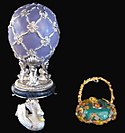 | Edouard and Maurice Sandoz Foundation, Switzerland | |
| 1907 | Rose Trellis |  | Walters Art Museum, Baltimore, Maryland, USA | |
| 1907 | Cradle with Garlands | 125px | Private collection Robert M. Lee, US | |
| 1908 | Alexander Palace | 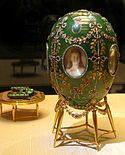 | Kremlin Armoury, Moscow, Russia | |
| 1908 | Peacock | 125px | Edouard and Maurice Sandoz Foundation, Switzerland | |
| 1909 | Standart Yacht | 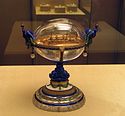 | Kremlin Armoury, Moscow, Russia | |
| 1909 | Alexander III Commemorative | 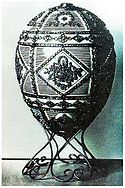 | สูญหาย | |
| 1910 | Colonnade | 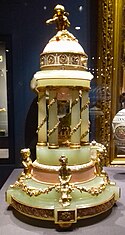 | The Royal Collection, London, UK | |
| 1910 | Alexander III Equestrian | 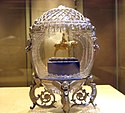 | Kremlin Armoury, Moscow, Russia | |
| 1911 | Fifteenth Anniversary |  | Viktor Vekselberg | |
| 1911 | Bay Tree | 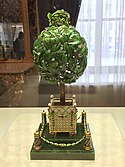 | Also known as the Orange Tree egg | Viktor Vekselberg |
| 1912 | Czarevich or Tsarevich |  | Virginia Museum of Fine Arts, Richmond, Virginia, USA | |
| 1912 | Napoleonic | 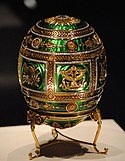 | Matilda Geddings Gray Foundation. Displayed at the Metropolitan Museum of Art, New York, USA | |
| 1913 | Romanov Tercentenary | 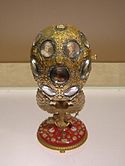 | Kremlin Armoury, Moscow, Russia | |
| 1913 | Winter | 125px | The State of Qatar | |
| 1914 | Mosaic | 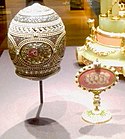 | The Royal Collection, London, UK | |
| 1914 | Grisaille (also known as the Catherine the Great Egg) | 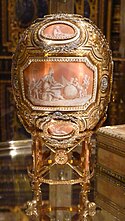 | The egg was made by Henrik Wigström, "Fabergé's last head workmaster". It was given to Maria Fedrovna by her son Nicholas II. Its surprise (now lost) was "a mechanical sedan chair, carried by two blackamoors, with Catherine the Great seated inside".[7] | Hillwood Museum, Washington, D.C., USA |
| 1915 | Red Cross with Triptych | 125px | Cleveland Museum of Art, Cleveland, Ohio, USA | |
| 1915 | Red Cross with Imperial Portraits | 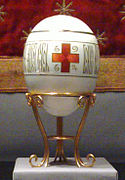 | Virginia Museum of Fine Arts, Richmond, Virginia, USA | |
| 1916 | Steel Military | 125px | Kremlin Armoury, Moscow, Russia | |
| 1916 | Order of St. George | 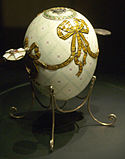 | Made during World War I, the Order of St. George egg commemorates the Order of St. George that was awarded to Emperor Nicholas and his son, the Grand Duke Alexei Nikolaievich.[8] The Order of St. George egg and its counterpart the Steel Military egg were given a modest design in keeping with the austerity of World War I,[9] and Fabergé billed 13,347 rubles for the two.[8] The Order of St. George egg left Bolshevik Russia with its original recipient, the Dowager Empress Maria Feodorovna.[10] | Viktor Vekselberg |
| 1917 | Karelian Birch | 125px | Created in 1917, the egg was due to be completed and delivered to the tsar that Easter, as a present for his mother, the Empress Maria Feodorovna. But before the egg could be delivered, the February Revolution took place and Nicholas II was forced to abdicate on March 15. On April 25, Fabergé sent the Tsar an invoice for the egg, addressing Nicholas II not as "Tsar of all the Russians" but as "Mr. Romanov, Nikolai Aleksandrovich". Nicholas paid 12,500 rubles and the egg was sent to Grand Duke Michael Alexandrovich at his palace, for presentation to the empress, but the duke fled before it arrived. The egg remained in the palace until it was looted in the wake of the October Revolution later that year | Alexander Ivanov. Displayed at Ivanov's Fabergé Museum in Baden-Baden, Germany. |
| 1917 | Constellation (ยังไม่สมบูรณ์) | 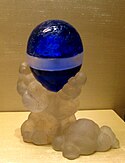 | Because of the Russian Revolution of 1917, this egg was never finished or presented to Tsar Nicholas's wife, the Tsaritsa Alexandra Feodorovna. Two eggs have claims to be the Constellation egg: one held at Fersman Mineralogical Museum in Moscow and the other in the possession of Alexander Ivanov and displayed at Ivanov's Fabergé Museum in Baden-Baden, Germany. | Fersman Mineralogical Museum, Moscow or the Fabergé Museum in Baden-Baden. |
อ้างอิง
แหล่งข้อมูลอื่น
 วิกิมีเดียคอมมอนส์มีสื่อเกี่ยวกับ ไข่ฟาแบร์เช
วิกิมีเดียคอมมอนส์มีสื่อเกี่ยวกับ ไข่ฟาแบร์เช
- Mieks; website on pictures, history, whereabouts... of Fabergé eggs
- Fabergé Research Site by Christel Ludewig McCanless เก็บถาวร 2009-04-06 ที่ เวย์แบ็กแมชชีน
- Details on each of the Fabergé Eggs
- BYU article on the eggs เก็บถาวร 2016-03-03 ที่ เวย์แบ็กแมชชีน
- "Oval Objects of Desire," Wall Street Journal review of new history of Faberge eggs